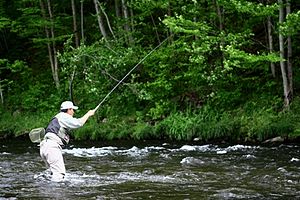 japanese history of fly fishing.....
japanese history of fly fishing.....The traditional Japanese method of fly-fishing is known as "Tenkara" (Japanese: テンカラ, literally: "from heaven"). The first reference to tenkara fly-fishing was in 1878 in a book called "Diary of climbing Mt. Tateyama".
Tenkara is the only fly-fishing method in Japan that is defined by using a fly and casting technique where the line is what is actually being cast. Tenkara originated in the mountains of Japan as a way for professional fishermen and inn-keepers to harvest the local fish, Ayu, Yamame, Iwana for selling and providing a meal to their guests. Primarily a small-stream fishing method that was preferred for being highly efficient, where the long rod allowed the fisherman to place the fly where the fish would be.
Another style of fishing in Japan is Ayu fishing. As written by historian Andrew Herd, in the book "The Fly", "Fly fishing became popular with Japanese peasants from the twelfth century onward...fishing was promoted to a pastime worthy of Bushi (warriors), as part of an official policy to train the Bushi's mind during peacetime." This refers primarily to Ayu fishing, which commonly uses a fly as lure, uses longer rods, but there is no casting technique required, it's more similar to dapping. Ayu was practiced in the lowlands (foothills), where the Bushi resided, tenkara practiced in the mountains. Fishing flies are thought to have first originated in Japan for Ayu fishing over 430 years ago. These flies were made with needles that were bent into shape and used as fishing hooks, then dressed as a fly. The rods along with fishing flies, are considered to be a traditional local craft of the Kaga region.
In the West, fly-fishing rods were primarily made of wood, which is heavy, so having long rods to reach spots where fish may be was tricky. Anglers started devising running line systems, where they could use shorter rods and longer lines. Eventually this led to the development of reels and the widespread use of shorter rods and reels. In Japan, bamboo, a very light material, was readily available, so anglers could make very long rods without much concern for weight. Fly-fishing remained more pure, as it was in its origins, anglers in Japan could continue using the long rods and did not feel the need to invent running line systems and reels.
methods.....
Tenkara fly-fishing
Tenkara fishing (Japanese: テンカラ) is a traditional type of fly-fishing practiced in Japan. Primarily used for small stream trout fishing, tenkara is one of the most popular methods of angling among fresh-water fisherman in Japan. Only a rod, tenkara line and fly are necessary for tenkara fishing (no reel is used). There is also a casting technique necessary for casting the near weightless fly forward, although casting with a tenkara rod is much more intuitive and easier.
In tenkara, the rods are very long and telescopic, usually between 12 - 15ft but collapsing down to about 20 inches or so. The line is attached directly to the tip of the rod. There are also other advantages of using the long tenkara rods when fishing in small streams, primarily the lightness of the line and delicate presentation. A long rod allows for precise placement of the fly on small pools and allows for holding the fly in place on the other side of a current. The other main advantage of using the long tenkara rod is precise control for manipulation of the fly.
The main appeal of tenkara is its simplicity and the fact that one uses the fewest elements to catch fish.
Spey Casting
Spey casting is a casting technique used in fly fishing. Spey casting requires a longer, heavier two-handed fly rod, referred to as a Spey rod. Spey casting is essentially a large roll cast
Spey casting is used for fishing large rivers for salmon and large trout such as steelhead and sea trout. Spey technique is also used in saltwater surf casting. All of these situations require the angler to cast larger flies long distances. The two-handed Spey technique allows more powerful casts and avoids obstacles on the shore by keeping most of the line in front of the angler.
Fly fishing for trout
Fly fishing for trout is a very popular sport, which can be done using any of the various methods and any of the general types of flies. Many of the techniques and presentations of fly fishing were first developed in fishing for trout. There is a misconception that all fly fishing for trout is done on the surface of the water with "dry flies." In most places, especially heavily fished trout areas, success usually comes from fly fishing using flies that were designed to drift on the bottom of the water. A trout feeds at the bottom of a river nearly 90 percent of the time. Trout usually only come to the surface when there is a large bug hatch (when aquatic insects grow wings and leave the water to mate and lay eggs). There are exceptions to this rule, however, particularly during the summer months and on smaller mountain streams Trout anglers should always be prepared with the right flies to match any circumstance.






No comments:
Post a Comment